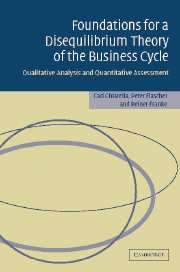 Foundations for a Disequilibrium Theory of the Business Cycle
Foundations for a Disequilibrium Theory of the Business Cycle Book contents
- Frontmatter
- Contents
- List of figures
- List of tables
- Foreword by J. Barkley Rosser, Jr.
- Preface
- Notation
- 1 Competing approaches to Keynesian macrodynamics
- Part I Textbook Approaches
- Part II Analytical Framework: Theory and Evidence
- Part III Monetary Policy
- 8 The Taylor rule in small macromodels
- 9 Incorporating the Taylor rule into KMG
- References
- Index
8 - The Taylor rule in small macromodels
Published online by Cambridge University Press: 22 September 2009
- Frontmatter
- Contents
- List of figures
- List of tables
- Foreword by J. Barkley Rosser, Jr.
- Preface
- Notation
- 1 Competing approaches to Keynesian macrodynamics
- Part I Textbook Approaches
- Part II Analytical Framework: Theory and Evidence
- Part III Monetary Policy
- 8 The Taylor rule in small macromodels
- 9 Incorporating the Taylor rule into KMG
- References
- Index
Summary
Introduction
The Keynes–Metzler–Goodwin model that has been extensively studied in chapters 4 to 7 has its roots in the IS-LM modelling framework. It has, however, extended the IS-LM textbook version in several ways; in particular, it drops IS as a temporary equilibrium relationship and admits goods market disequilibrium with the correspondingly induced changes of inventories, and it introduces nominal price and wage adjustment together with its consequences for income distribution and aggregate demand.
In contrast, the LM curve is taken over unaltered. The main criticism in this respect is not so much that LM is too simple as a representation of the financial markets as that this device in which the money supply features as an exogenous variable ignores an important change in central banking. That is, most central banks, including the US Federal Reserve, nowadays pay little attention to monetary aggregates in conducting policy. Over the last decade a general consensus has instead been reached that the central bank follows a (real) interest rate rule. In the fields of Keynesian modelling (whether ‘Old’ or ‘New’, whether purely backward-looking or also forward-looking with rational expectations), the consensus has grown so strong that it actually could be said to form a new paradigm.
It thus follows that the KMG model with its LM curve and the assumption of a constantly growing money supply cannot be considered to be a fully descriptive model of the economy.
- Type
- Chapter
- Information
- Foundations for a Disequilibrium Theory of the Business CycleQualitative Analysis and Quantitative Assessment, pp. 371 - 426Publisher: Cambridge University PressPrint publication year: 2005


